
Fauresmith
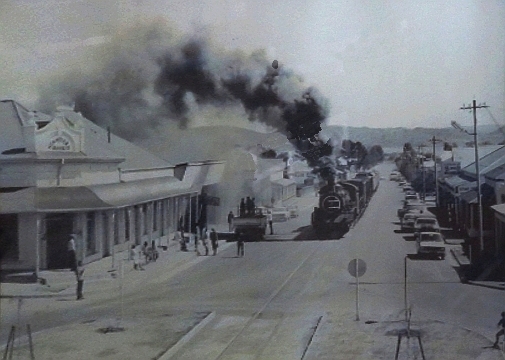
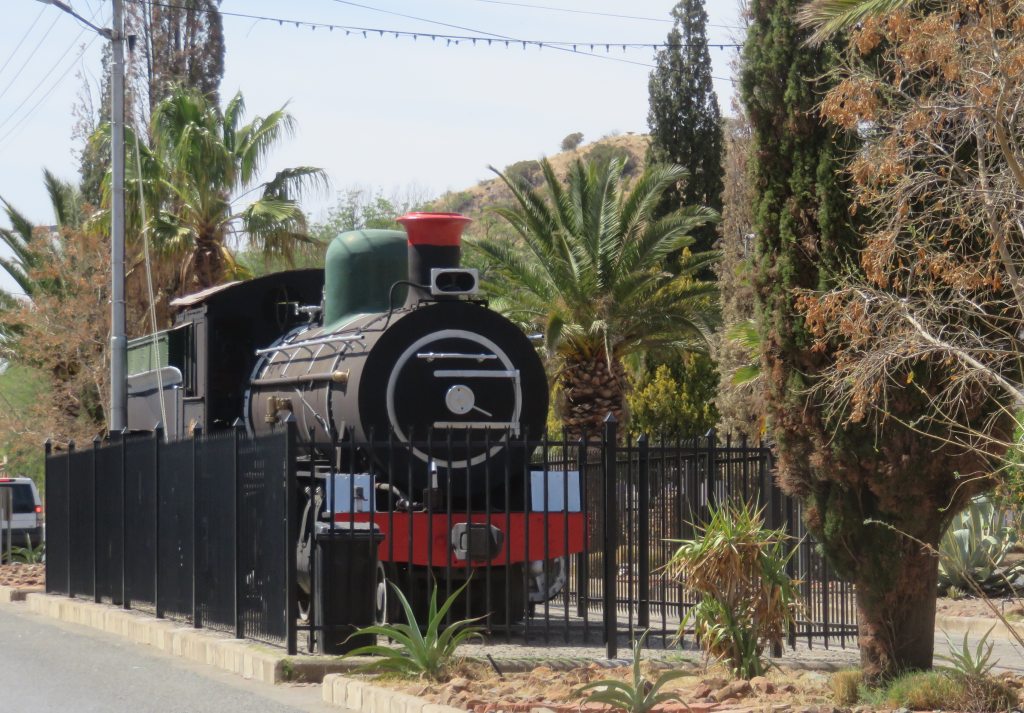 The town's main claim to fame is that a steam train used to ride down the main street. Unfortunately no more, since the rail closed down in 1999. A reminder is the locomotive mounted in the town centre. The locomotive on display comes from the North British Locomotive company and was build in 1903.
The town's main claim to fame is that a steam train used to ride down the main street. Unfortunately no more, since the rail closed down in 1999. A reminder is the locomotive mounted in the town centre. The locomotive on display comes from the North British Locomotive company and was build in 1903.
Fauresmith is a little town in the south of the Free State, about 130 km south-west of Bloemfontein, Geo-position: 29.7486°S, 25.317°E and 1367m a.m.s.l. The time of the first visit was October 2019.
History
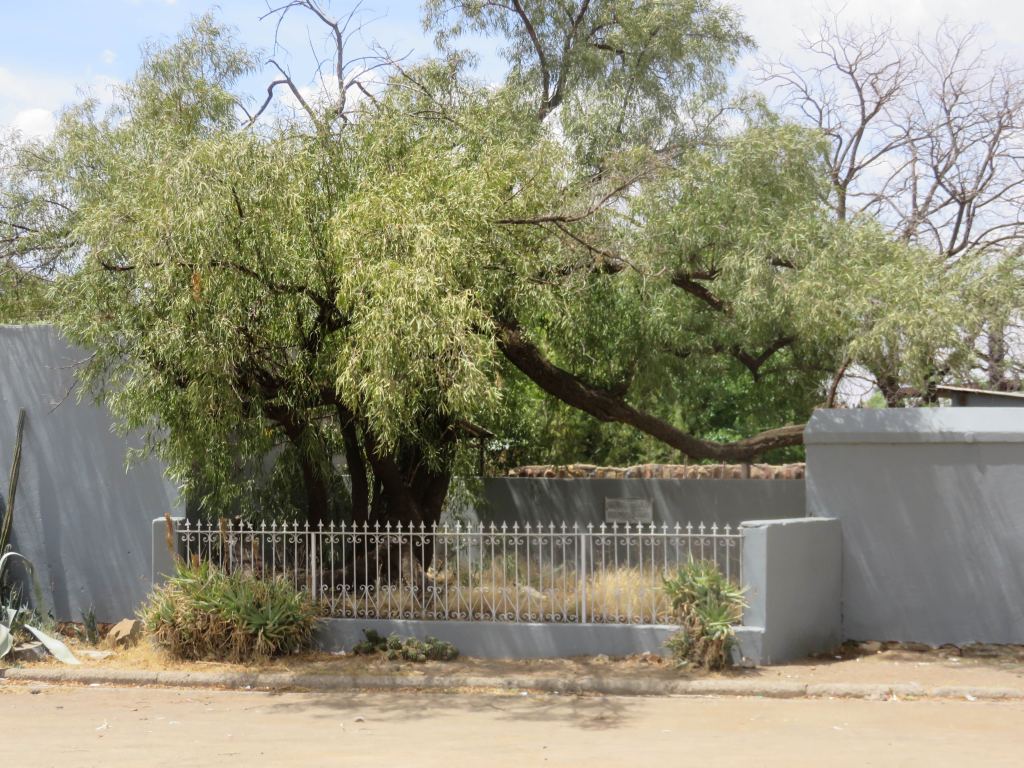 This is where it began, under this tree. The plaque mounted near the tree explains it, it reads: Under this tree Rev. Philip Faure and Rev. William Robertson, representatives of the Cape synodical commission, served the first holy communion in the Riet River Dutch Reformed congregation to 32 members on 9 November 1848.
In this website the events leading to the establishment of a town are described somewhat differently. It was Ds.WA Krige from the Victoria West congregation who came over the 'Groot Rivier' (referring to the Orange river} in 1846 to help the emigrants with religious matters. He was responsible for appointing some church elders and for collecting £700 for a church building fund. A commission got together on the 11 March 1848 at Groenkloof (I think that is at the future Fauresmith) to formally establish a congregation on the Rietriver. The first task for the church council was to find a place to build a church.
This is where it began, under this tree. The plaque mounted near the tree explains it, it reads: Under this tree Rev. Philip Faure and Rev. William Robertson, representatives of the Cape synodical commission, served the first holy communion in the Riet River Dutch Reformed congregation to 32 members on 9 November 1848.
In this website the events leading to the establishment of a town are described somewhat differently. It was Ds.WA Krige from the Victoria West congregation who came over the 'Groot Rivier' (referring to the Orange river} in 1846 to help the emigrants with religious matters. He was responsible for appointing some church elders and for collecting £700 for a church building fund. A commission got together on the 11 March 1848 at Groenkloof (I think that is at the future Fauresmith) to formally establish a congregation on the Rietriver. The first task for the church council was to find a place to build a church.
The council immediately started on a temporary church and they acquired the land, that is the farm Sannah's Poort, from Mr WD Jacobs for £1050. The position of the church was about where the locomotive is standing now, in those days it was called market square. They also went and laid out a town and started selling stands, that was 1849/1850.
Initially a town administered by the church, the first town councilors were elected in 1854 when the Orange Free State got its independence back from Britain. It officially became a municipality in 1859.
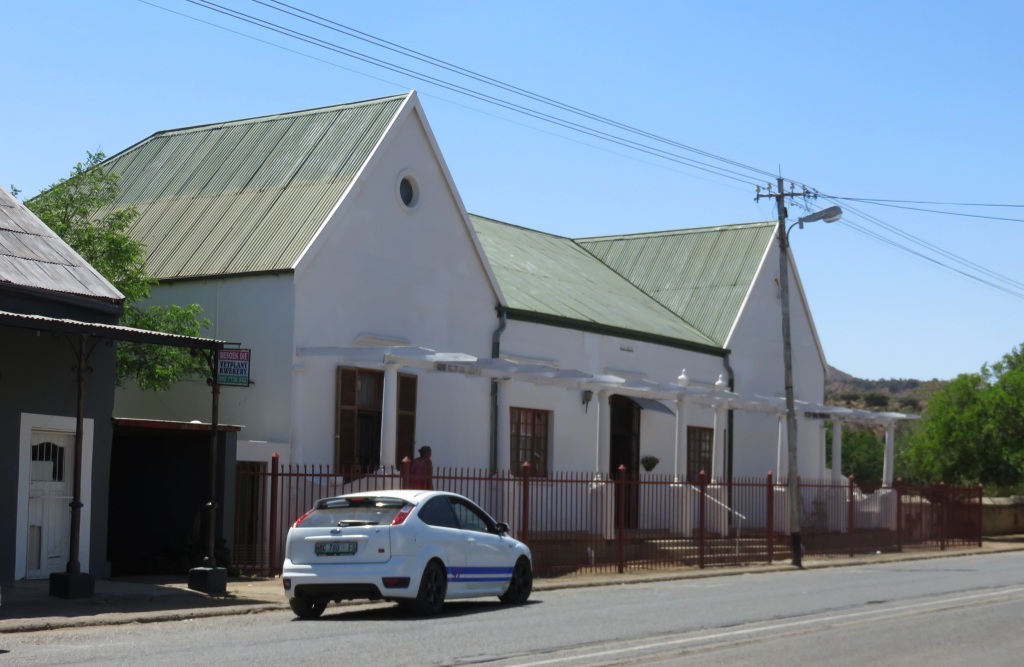 Emil Holub was here in 1872 on his way to the diamond fields, he writes in Ref 3: The town Fauresmith has the same character as all the towns in the Free State. It only consists of about 80 houses, occupying a remarkably large area. The clean white-washed houses with flat roofs surrounded by green gardens make a positive impression. Fauresmith is the seat of a magistrate and is in general one of the most important towns in the Orange Free State.
Emil Holub was here in 1872 on his way to the diamond fields, he writes in Ref 3: The town Fauresmith has the same character as all the towns in the Free State. It only consists of about 80 houses, occupying a remarkably large area. The clean white-washed houses with flat roofs surrounded by green gardens make a positive impression. Fauresmith is the seat of a magistrate and is in general one of the most important towns in the Orange Free State.
Where did the name come from? It is a combination of Faure, the moderator of the NG church who played a pivotal role in the founding of the town and Sir Harry Smith, the governor of the Cape at the time.
town buildings
The buildings, that is what makes Fauresmith such an attractive place. Space doesn't allow me to show all of them, a small sample will have to do. I call the above picture the oldest house, but I am not sure. It is in the main-street and it is marked to have been built in 1875.
There are lots more buildings, but there is not enough space for all the pictures. I have thus prepared another page which I call the Fauresmith Gallery. Its a collection of more pictures of the town.
NG Church
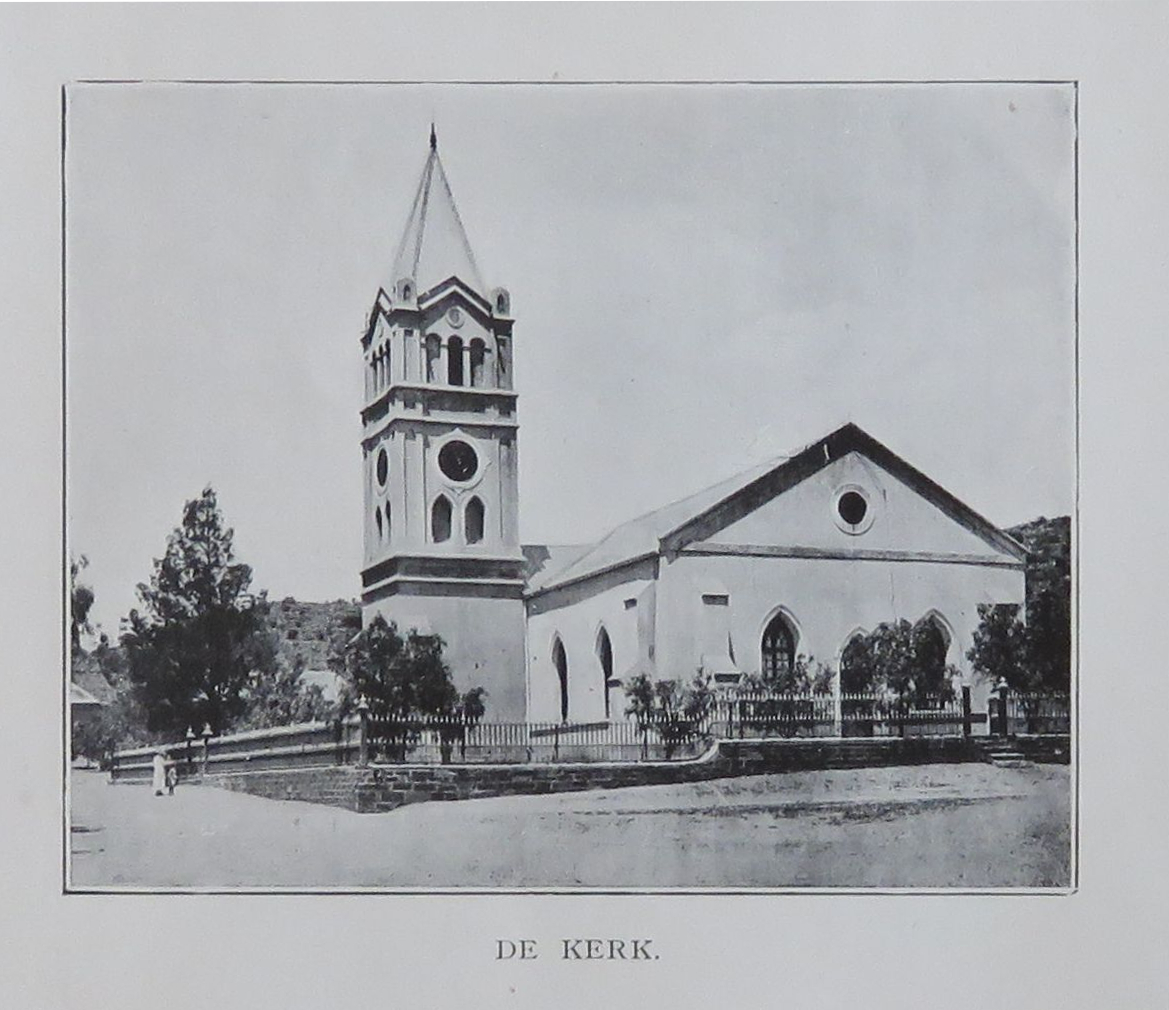
 In 1856 the congregation felt strong enough to build a permanent church. That is the church in the picture, but without the tower, the tower only came in 1875. And it was not build in the center, but two roads up. This stately building was replaced by a more modern church in 1962, see picture on the right.
In 1856 the congregation felt strong enough to build a permanent church. That is the church in the picture, but without the tower, the tower only came in 1875. And it was not build in the center, but two roads up. This stately building was replaced by a more modern church in 1962, see picture on the right.
The first minister was AA Louw who took up the position in 1855, he was followed by HJ Luckhoff in 1868. There is a bit of a story around Ds.Luckhoff. He is, by the way, the person that the town Luckhoff is named after. He was a very energetic and also nervous person which made him come into conflict with some of the members of the congregation. And what caused the biggest stirr was when he wrote to the newspaper complaining about the conduct of a fellow minister (Ds van Lingen of Harrismith) who got himself involved in politics. Having this discussion in the newspaper was a disgrace, it should be handled internally, so some of the members of the congregation felt. And since they were unhappy with their minister anyway this was used to start the process of his dismissal.
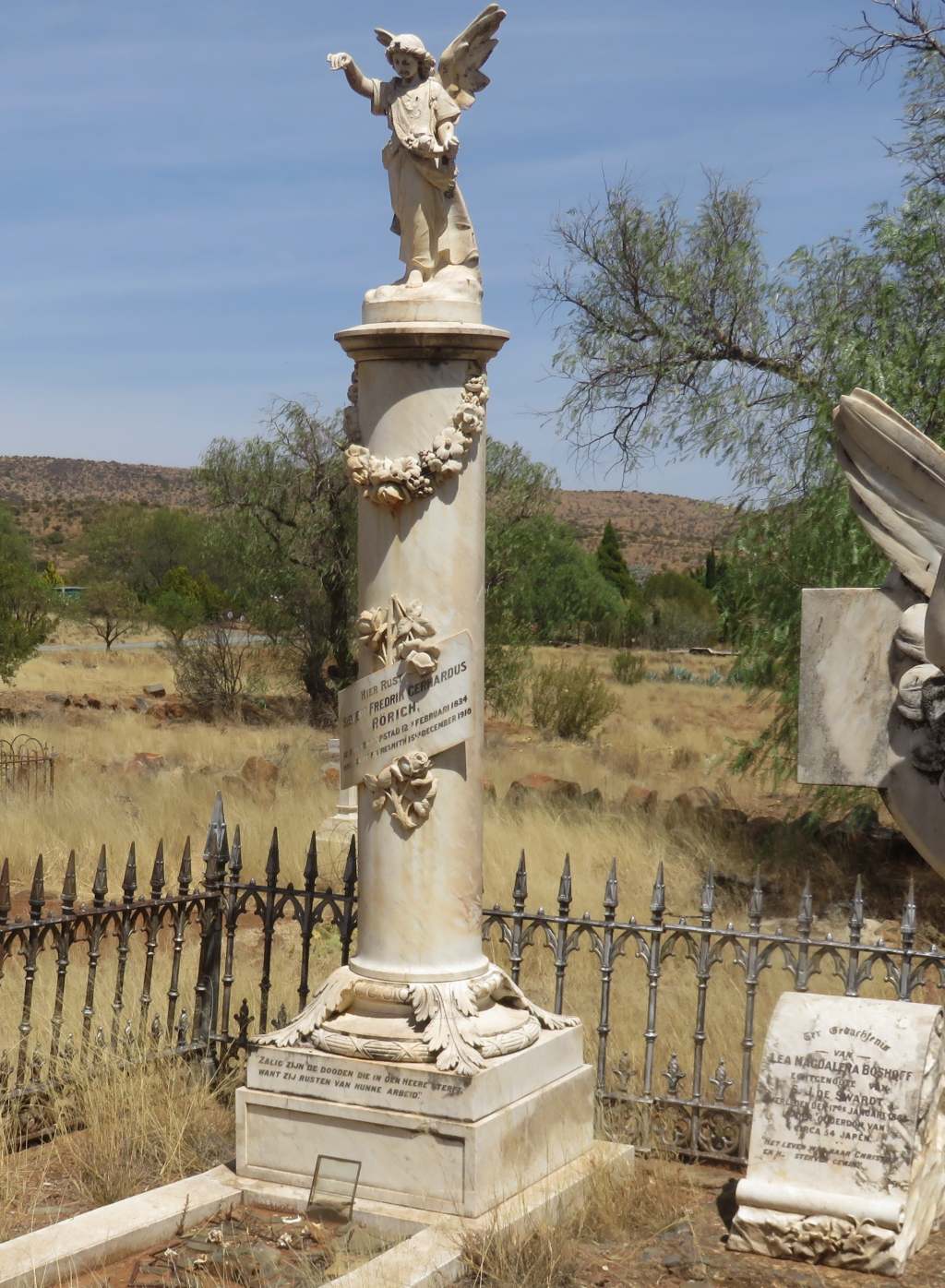 They negotiated a severance package of £800, that was a large sum for these days and was possibly the retirement funding for the dominee. It was Siewert Rörich who put up the money. He had gotten rich in the diamond boom of Koffiefontein and could afford to pay that sum. And here is his grave, that of Siewert Rörich, it reads, translated: here rests; Siewert Frederik Gerhardus; Rörich; born in Cape Town 12th February 1834; died Fauresmith 15th December 1910.
They negotiated a severance package of £800, that was a large sum for these days and was possibly the retirement funding for the dominee. It was Siewert Rörich who put up the money. He had gotten rich in the diamond boom of Koffiefontein and could afford to pay that sum. And here is his grave, that of Siewert Rörich, it reads, translated: here rests; Siewert Frederik Gerhardus; Rörich; born in Cape Town 12th February 1834; died Fauresmith 15th December 1910.
The source of this story is the wall of the Phoenix restaurant in the main street, they have pictures and newspaper cuttings
on display.
The Railway
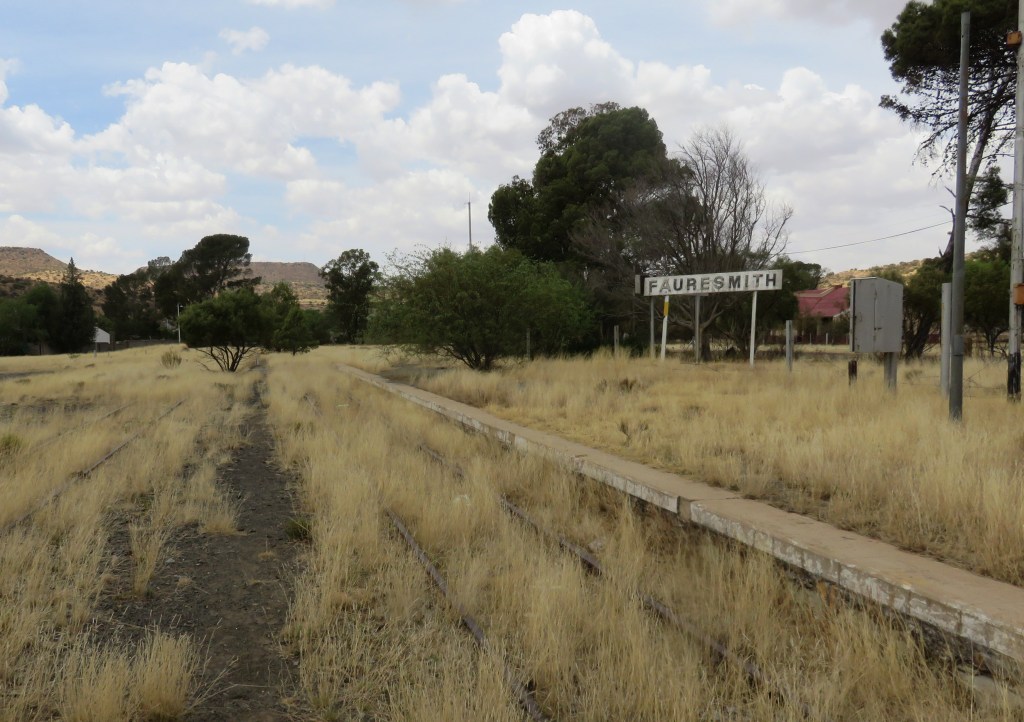 The railway line from Springfontein connecting Jagersfontein, Fauresmith and Koffiefontein was built in stages. 1905 to Jagersfontein, 1906 to Fauresmith and 1915 this was extended to Koffiefontein.
The railway line from Springfontein connecting Jagersfontein, Fauresmith and Koffiefontein was built in stages. 1905 to Jagersfontein, 1906 to Fauresmith and 1915 this was extended to Koffiefontein.
The question, of course, arises why did they take the rail through the middle of the town? I don't have a definitive answer. 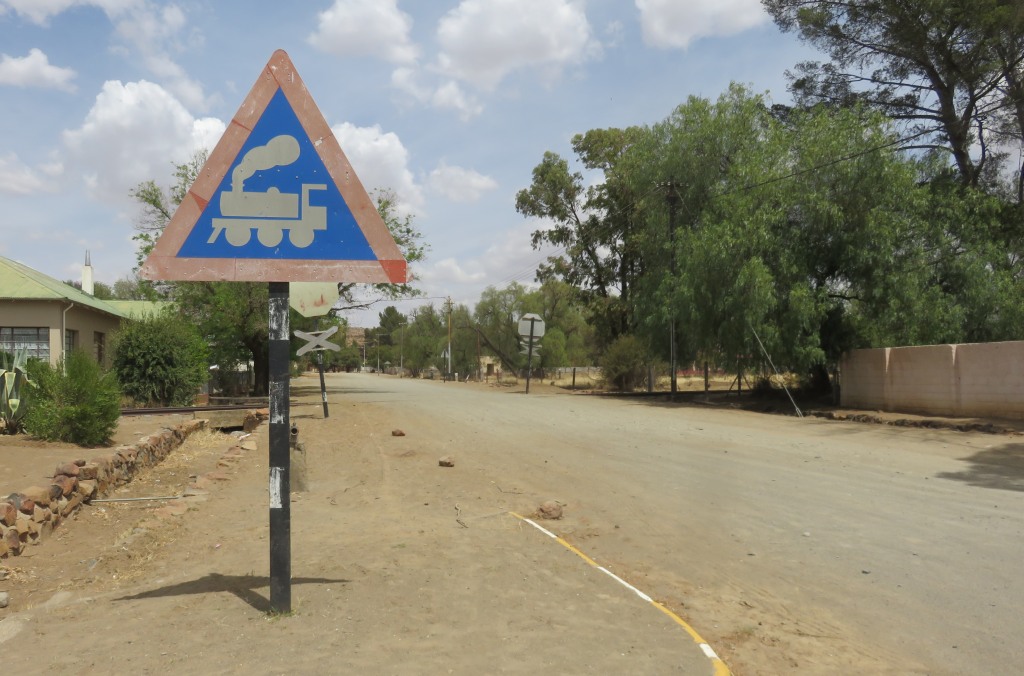 When looking at Google Earth one gets the impression that this was the logical way. The narrow gap through which road and rail had to squeeze between the hills coming into town from Jagersfontein basically 'forced' the rail onto the road.
When looking at Google Earth one gets the impression that this was the logical way. The narrow gap through which road and rail had to squeeze between the hills coming into town from Jagersfontein basically 'forced' the rail onto the road.
The rail comes off the main-road just before market street and cuts across to the station. It feels strange to still see a road sign warning of a train crossing knowing that this last happened 20 years ago. None of the station buildings have remained, but the rails are still there.
Cemetery

 Standing on the northern corner of the cemetery is the burger monument, a monument to the burgers of the district who died during the Anglo Boer war. The names of those who died in the conflict are inscribed in the stone. Also noted a number of unknown soldiers from various localities. I am not sure that this is just symbolic. Or were there burgers who died and nobody knew who they were?
Standing on the northern corner of the cemetery is the burger monument, a monument to the burgers of the district who died during the Anglo Boer war. The names of those who died in the conflict are inscribed in the stone. Also noted a number of unknown soldiers from various localities. I am not sure that this is just symbolic. Or were there burgers who died and nobody knew who they were?
The British also have a small section of the grave yard, I counted 15 graves. Possibly an indication of the relatively low war activities in this area.
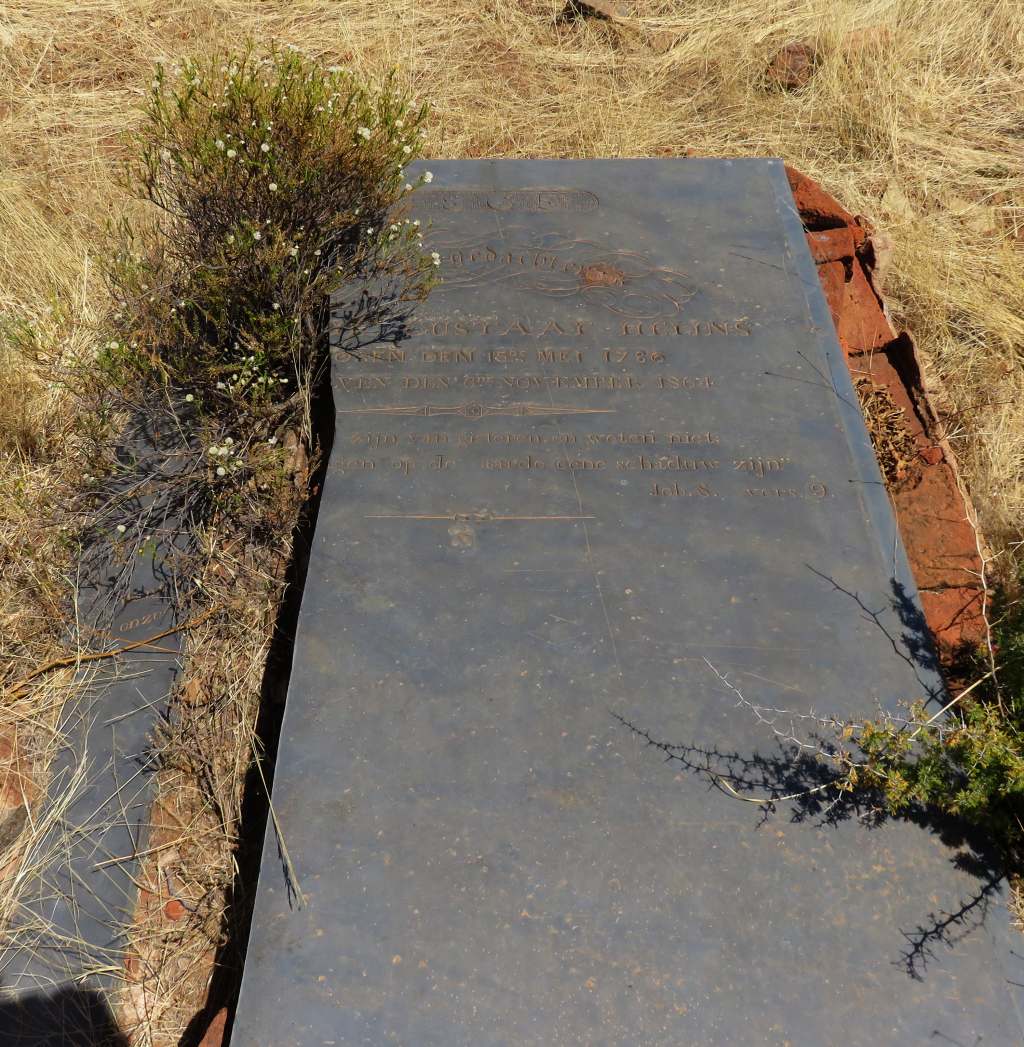 With a town of this age there would be lots of 'old' grave stones, many of them having become undecipherable. I just pick on one of them as an example. The grave plate has split in its length, what I can read is: Eredo??? Gustaaf Heyjns; born 15-May-1786; died 6-Nov-1864. Another grave stone, that of S Rörich, is shown above with it's story.
With a town of this age there would be lots of 'old' grave stones, many of them having become undecipherable. I just pick on one of them as an example. The grave plate has split in its length, what I can read is: Eredo??? Gustaaf Heyjns; born 15-May-1786; died 6-Nov-1864. Another grave stone, that of S Rörich, is shown above with it's story.
Kalkfontein Dam
The Kalkfontein Dam, about 25km out of Fauresmith, was built in 1938 to supply the mines and towns in the area, and also to serve as a irrigation dam. It was renovated and the height increased by 2.5m in 1977. There are two places of interest around this dam.
Anglo Boer War memorial
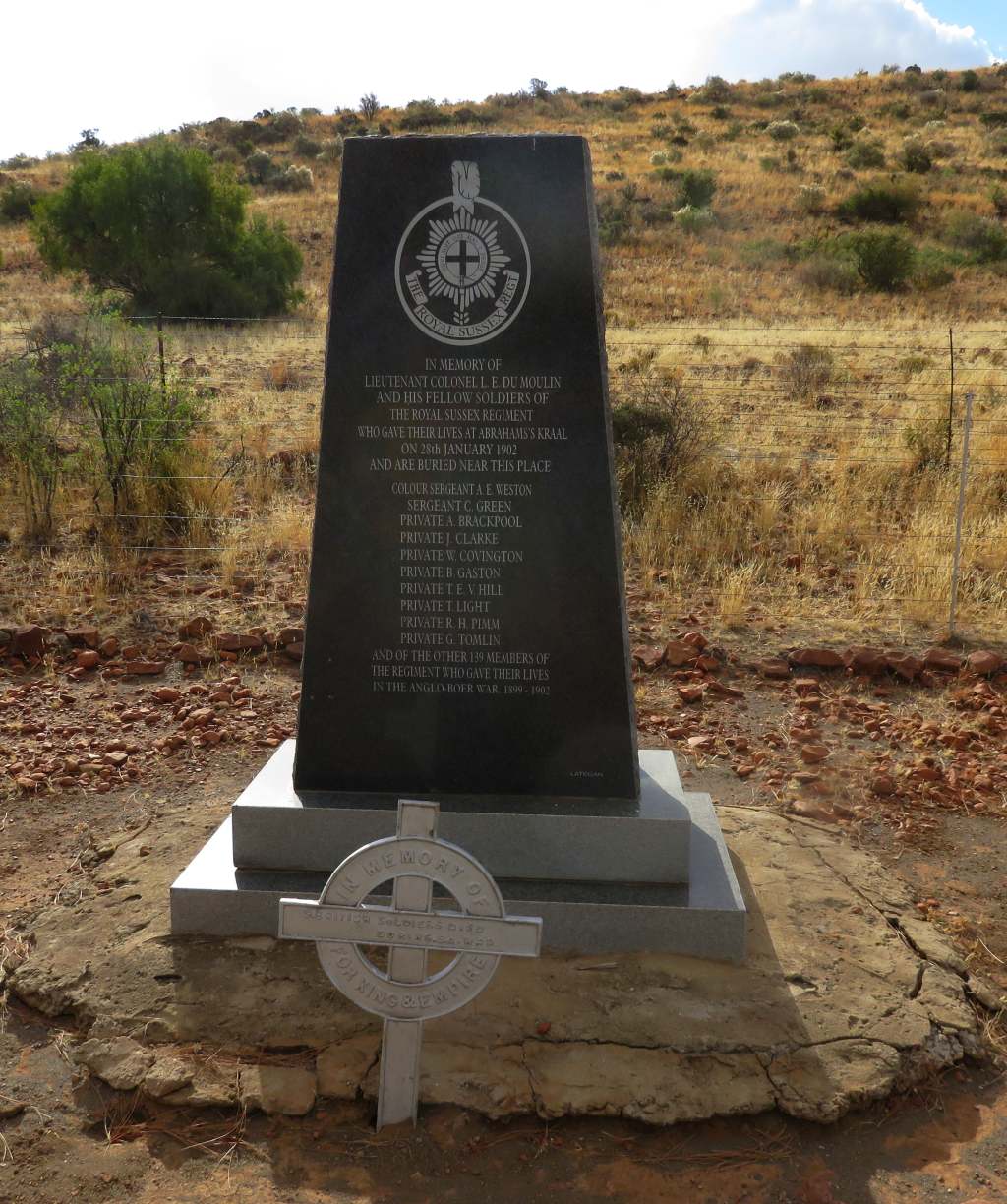 Coming up towards the dam wall there is a monument on the left, it is to fallen British soldiers during a skirmish that took place here during the Anglo Boer war (1899-1902). 11 soldiers lost their life's including the commander Lieutenant Colonel LE Du Moulin. The inscription reads: In memory of;Lieutanant Colonel L.E.Du Moulin; and his fellow soldiers of; the Royal Sussex regiment; who gave their lives at Abrahams's kraal; on 28th January 1902; and are burried near this place; Colour Sergeant A.E.Weston; Sergeant C.Green; Privat A.Brackpool; Private J.Clarke; Private W.Covington; Private B.Gaston; Private T.E.V.Hill; Private T.Light; Private R.H.Pimm; G.Tomlin; and of the other 139 members; of the regiment who gave their lives; in the Anglo Boer war. 1899-1902. I make it easy on myself and just quote straight from Ref 4.
Coming up towards the dam wall there is a monument on the left, it is to fallen British soldiers during a skirmish that took place here during the Anglo Boer war (1899-1902). 11 soldiers lost their life's including the commander Lieutenant Colonel LE Du Moulin. The inscription reads: In memory of;Lieutanant Colonel L.E.Du Moulin; and his fellow soldiers of; the Royal Sussex regiment; who gave their lives at Abrahams's kraal; on 28th January 1902; and are burried near this place; Colour Sergeant A.E.Weston; Sergeant C.Green; Privat A.Brackpool; Private J.Clarke; Private W.Covington; Private B.Gaston; Private T.E.V.Hill; Private T.Light; Private R.H.Pimm; G.Tomlin; and of the other 139 members; of the regiment who gave their lives; in the Anglo Boer war. 1899-1902. I make it easy on myself and just quote straight from Ref 4.
On the night of January 27th du Moulin camped opposite Abrahamskraal on the left bank of the Riet river, having pushed some of the enemy across the drift during the day. The night's dispositions consisted of a series of piquets posted on a semi-circle of kopjes overlooking the river; behind these, on either side of a small farmhouse, lay the horse lines and the parked transport wagons.
At one o'clock on the morning of the 28th the sentries at the drift heard the sound of men fording the water. Before
warning could be given, the whole piquet was overwhelmed by a rush of burghers who, seizing the point of vantage, kept
the gap open whilst a strong body poured through into the camp. In a moment the horse lines and the outbuildings of the
farmhouse were theirs, and every comer was searched by bullets. Du Moulin, who had passed the night in the house, emerged at
the first shots, and calling a few men round him led a charge against the nearest Boers. He himself, with several others, fell
dead immediately, but the kraals were cleared, and soon after another determined counter-stroke against the position of the
piquet which had been first destroyed regained that also, and at 1.45 a.m. the enemy fell back. Brevet-Major A. R.
Gilbert (Royal Sussex regiment) had now assumed command in place of du Moulin, and he quickly redistributed his men
along the line of defense. His promptitude was fortunate, for in an hour's time a second attack was delivered against the
outposts. This was smartly repulsed, and was not repeated. This affair cost the column its commander and ten men killed,
six men wounded, and nearly 150 horses and mules lost or destroyed. The enemy left three on the field, and carried off
some dozen wounded, for some of whom they next day begged an ambulance from Gilbert.
Steelbridge over the Riet River
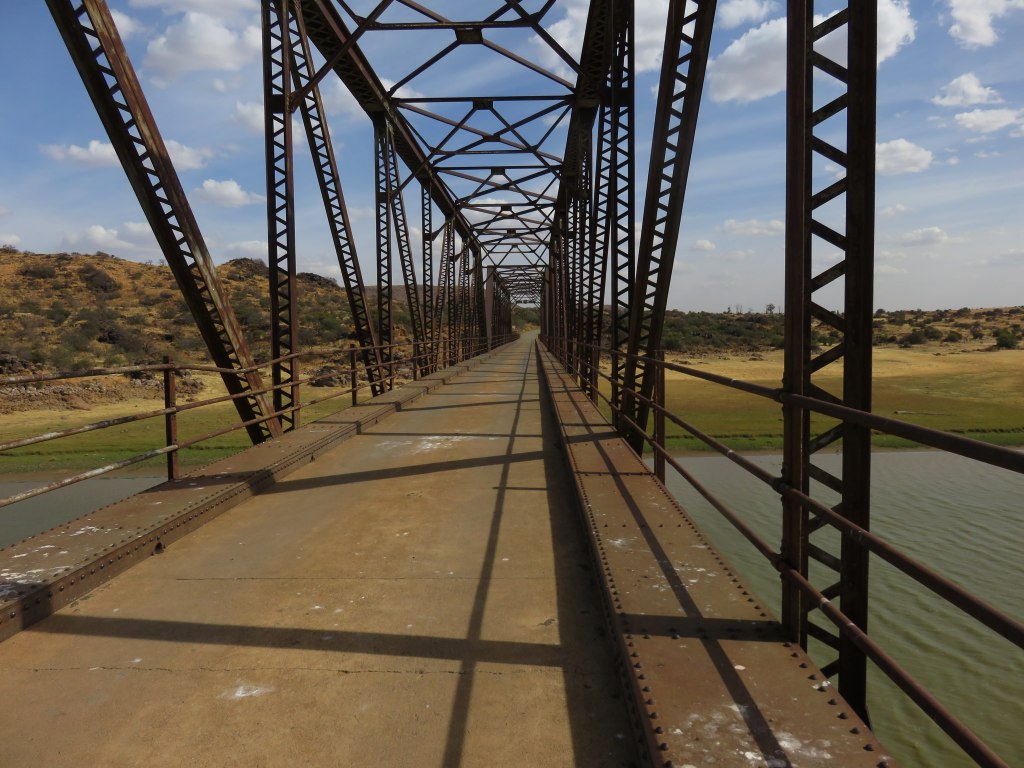 At the upper end of the dam is a multi arch steel bridge over the Riet River. What is so special about this bridge? It was built during WW2 by Italian prisoners of war. At that time Italian POW's were used in many projects to help with infra structure improvement. In this case building a bridge on the road between Fauresmith and Petrusburg. Interesting to note that the steel came from Dorman Long in Middlesborough England. I would have thought that all the steel produced in Britain at the time would have been used to throw at the Germans.
At the upper end of the dam is a multi arch steel bridge over the Riet River. What is so special about this bridge? It was built during WW2 by Italian prisoners of war. At that time Italian POW's were used in many projects to help with infra structure improvement. In this case building a bridge on the road between Fauresmith and Petrusburg. Interesting to note that the steel came from Dorman Long in Middlesborough England. I would have thought that all the steel produced in Britain at the time would have been used to throw at the Germans.
References
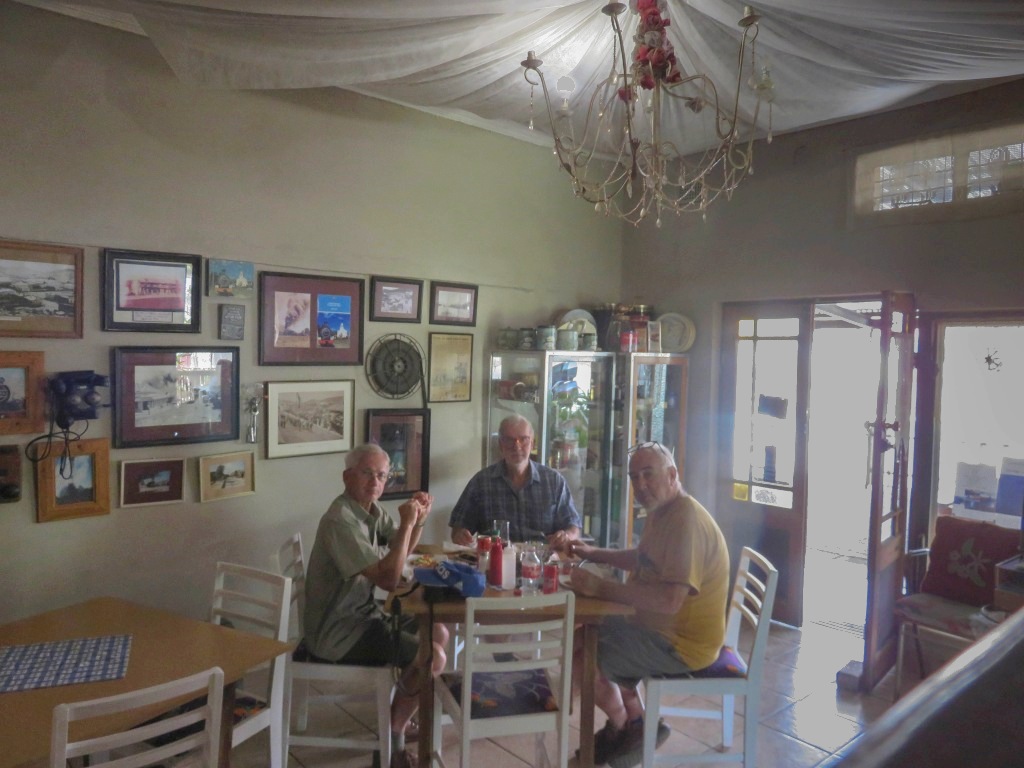 Ref 1.: Standard Encyclopedia of Southern Africa, Nasou Limited, 1974
Ref 1.: Standard Encyclopedia of Southern Africa, Nasou Limited, 1974
Ref 2.: "Ons Kerk Album van Hollandsche Kerken en Leeraren", publisher: unknown, printed in the 1920's
Ref 3.: Emil Holub "Sieben Jahre in Süd-Afrika", subtitle: "Erlebnisse, Forschungen und Jagden auf meinen Reisen von den Diamantenfeldern zum Zambesi (1872-1879)", printed Wien 1881.
Ref 4.: Captain Maurice Harold Grant, "History of the War in South Africa 1899-1902", Vol.4, printed 1910
Ref 5.: a fair amount of information comes from the displays in the Phoenix restaurant in the main street, they have pictures and newspaper cuttings all around the walls.